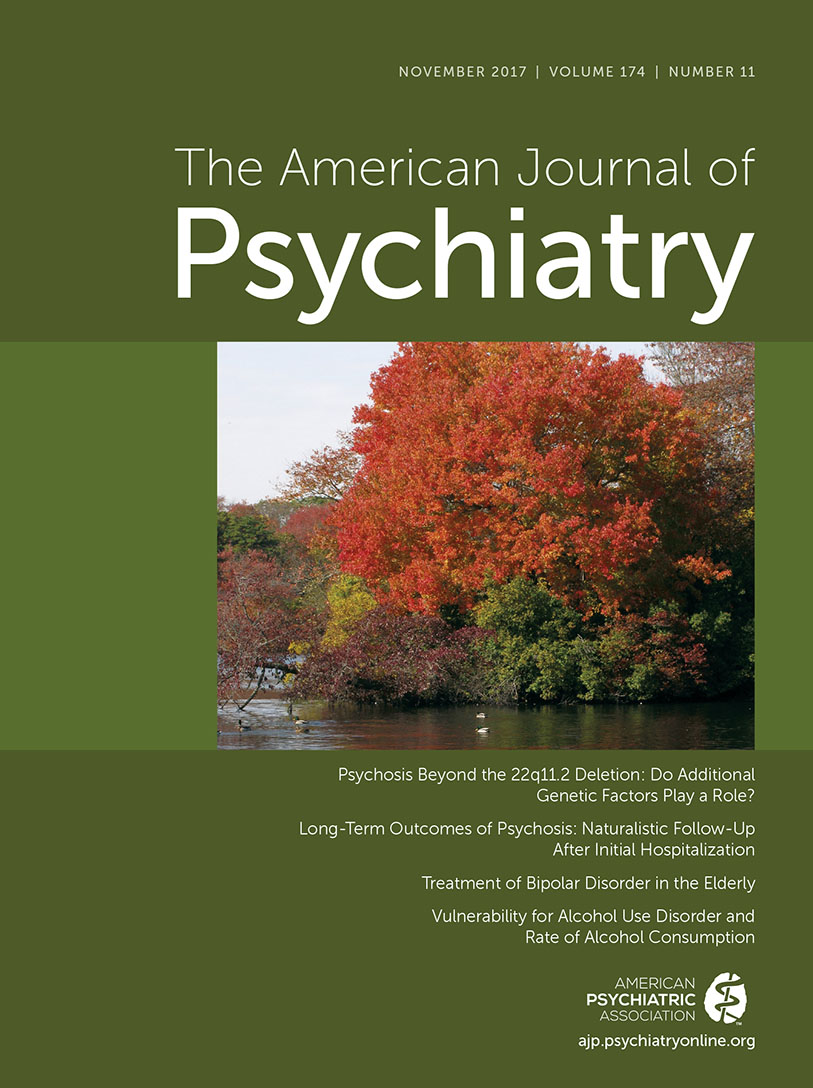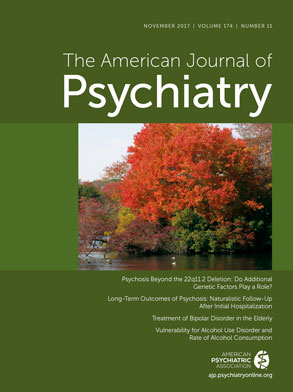The article by Gowin et al. (
1), in this issue of the
Journal, describes a study evaluating characteristics that represent risk factors for the development of alcohol use disorder. The authors carefully examined a large sample of healthy social drinkers using an innovative laboratory paradigm and found that family history of alcoholism, male sex, and impulsivity—when combined—were associated with high rates of binge drinking during the laboratory paradigm. This study documents different patterns of alcohol exposure within individual drinking sessions. The findings suggest that those with characteristics associated with a higher risk of developing alcohol use disorder experienced higher alcohol exposure within sessions. The authors conclude that young social drinkers at risk for alcohol use disorder have markedly different patterns of drinking and encourage the evaluation of binge drinking in clinical settings as a potential indicator of vulnerability to alcohol use disorder.
This study is quite timely, and its publication for a wide psychiatric audience is important given the recently documented increase in the prevalence of alcohol use disorder. Over the past decade, there has been a dramatic increase in rates of alcohol use, high-risk drinking, and alcohol-related conditions (
2). This despite scientific advances in the understanding of the underlying neurobiology (
3), genetics (
4), and treatment of alcohol use disorder (
5). The high rates of consumption with the resultant medical consequences and socioeconomic cost represent a public health crisis. The finding that high-risk drinking is on the rise suggests that understanding factors that influence problematic drinking patterns and targeting high-risk groups should be a priority for health care professionals.
The present study does exactly that. It extends the existing literature about risk factors associated with vulnerability for alcohol use disorder. The risks of developing alcohol use disorder include a strong family history of alcoholism (
6), sex (
6), and impulsivity (
7). Research on understanding the mechanisms of these underlying risks has focused on altered subjective response to alcohol in the laboratory, for example, based on family history (
8), impulsivity (
9), and genotype (
10). Nevertheless, conflicting results have been reported (
11), and discrepant hypotheses on the relationship of subjective response to family history have been proposed (
8). In addition, it is hard to control for other factors, and some studies have suggested that drinking history, rather than family history, is the important factor determining alcohol response and subsequent risk (
12). Furthermore, subjective response may or may not lead to differences in drinking patterns outside of laboratory settings.
This study extends previous findings in two important ways. First of all, the authors have simultaneously evaluated several different previously identified factors. Results from this study suggest that the risk factors are additive, which is both intuitive and important when considering a complex disorder such as alcohol use disorder. More importantly, however, the authors have evaluated these risk factors pertaining to actual patterns of drinking or alcohol exposure within a controlled laboratory setting. These data would be hard to collect outside a laboratory setting, given the limitations of self-report of alcohol use and the introduction of other factors that might complicate results. Given the recent epidemiologic findings, results suggesting that family history is related to alcohol exposure and binge drinking, rather than subjective response, indicate that binging may be a more meaningful clinical phenomenon.
The methodology of this study deserves to be highlighted. There are many paradigms used in research that provide a platform for understanding factors thought to be important to vulnerability and relapse; these include subjective effects of alcohol, alcohol consumption patterns, and related phenomenon such as craving. Paradigms using oral alcohol administration, including self-administration, while ecologically valid cannot control for factors such as variable absorption and metabolism (
13). The novel paradigm used in this study is a self-administration intravenous paradigm, which controls for interindividual differences, and eliminates cues (which may be both a strength and a weakness) and is thought to reflect pure pharmacologic effects. This paradigm has been used to test both medication and genetic effects (
14,
15). It has the potential to be an important tool in medication development, as a way to test novel compounds before conducting larger clinical trials.
There are several limitations of this study that should be acknowledged. The elimination of factors that influence drinking are also a weakness, since expectancy, taste, and environmental cues influence drinking in a “real-world” environment. As such, this paradigm loses some ecological validity. As the authors point out, the cross-sectional design is a limitation, and they suggest that longitudinal work would be an important next step when evaluating whether the drinking patterns noted in the laboratory are associated with long-term risk of the development of alcohol use disorder.
Despite these limitations, the undertaking of well-designed, laboratory studies identifying risk factors for the development of alcohol use disorder is sorely needed. Despite decades of work in the alcohol-related field, findings have not influenced actual behavior as measured by the prevalence of alcohol use disorder or of alcohol-related medical consequences. As the treatments developed have modest efficacy and poor uptake (
16), efforts toward preventing the development of alcohol use disorder could have important benefits. The authors make the clinical point that binge drinking may be an indicator of vulnerability and should be assessed. This perhaps should be taken a step further, since evidence is mounting that there are clinical characteristics that influence risk. There is sufficient evidence to support a good clinical evaluation that includes the assessment of other factors such as family history and impulsivity as possible risk factors, which may lead to binge drinking and increase the risk. It is important for the scientific community to develop assessments and interventions that can be disseminated widely to evaluate and address alcohol use-related disorders.

